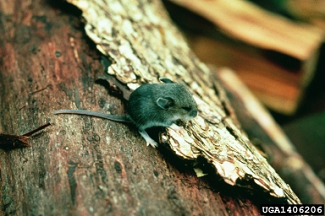Take Steps Now to Keep Mice Out This Fall
By Chris Williams on August 21, 2015.

We’re rapidly approaching the time of year when we start to get inundated with mouse calls. Why? You would think mice would be more active in the summer months than in the fall. They are, but they’re more active outside. When the temperature starts to drop and the days shorten, mice are driven to look for winter shelter. Your nice warm house is looking pretty good to them about now.
Your House Has No Barriers to Mice
The good news for the mouse is that it’s extremely easy to get inside the average home. There are plenty of mouse-size openings near ground level and also near the roofline. Their small body size allows a young mouse to squeeze through a slot-like opening that is little more than ¼-inch high. If an opening is too small, a mouse will gnaw the edges to make it just large enough. A typical entrance point is around pipes. Mice will chew a small opening at any edge that opens into a void, or at the corner of a door so they can squeeze through when the door is closed. You can see why caulking openings is important. So is making sure that vents are screened, that doors have thresholds and weather-stripping, and that soffits are repaired.
Garage doors might be the number one entry point for mice. Very few older garage doors still have a tight seal. There are usually gaps in the bottom corners of the door and rubber thresholds wear and tear, and are easy to chew through. Once inside a garage, mice can access any part of your home by following lines or traveling in wall voids.
Mice can get into attics from the exterior by climbing up outside walls or by walking tree branches, cables, or lines that enter the attic and then squeezing into the opening where the lines enter the house. Once near the roofline, mice can usually find lots of small openings that will allow them access to the attic or roof void. Mice can also get into attics once they are inside your home or garage. They simply travel along electrical lines or pipe chases inside wall voids, then up through the ceiling, or they enter through light fixtures or vent fans. Once inside, mice can move from ceiling voids into wall voids, or vice versa.
Let Us Mouse-Proof Your Home to Keep Mice Out
The way to stop mice from entering your home is to take measures that we call exclusion or “mouse-proofing.” This simply means closing holes, sealing gaps, tightening doors, screening vents – basically eliminating all the potential mouse entry points that you can find. The good news is that doing that keeps many insect pests out, too. At Colonial Pest, one of our specialties is pest exclusion. Our trained technicians know how to find and seal all those little openings that let mice inside. We use quality, warrantied materials to provide a permanent pest solution…and our work is guaranteed. Ask us about our pest exclusion program now, before the mice move in!
For more on mouse-proofing your home, check out these informational blogs:
- How Do Mice Get Into Houses?
- Why Are There Mice in My Attic?
- Mouse-proofing Your Home – Advice From the Pros
- Pest-proofing Doors to Keep Pests Out
- Maintain Your Garage Door to Keep Mice Out
- Using Caulks to Keep Pests Out
Photo Credit: USDA Forest Service – North Central Research Station Archive, USDA Forest Service, Bugwood.org